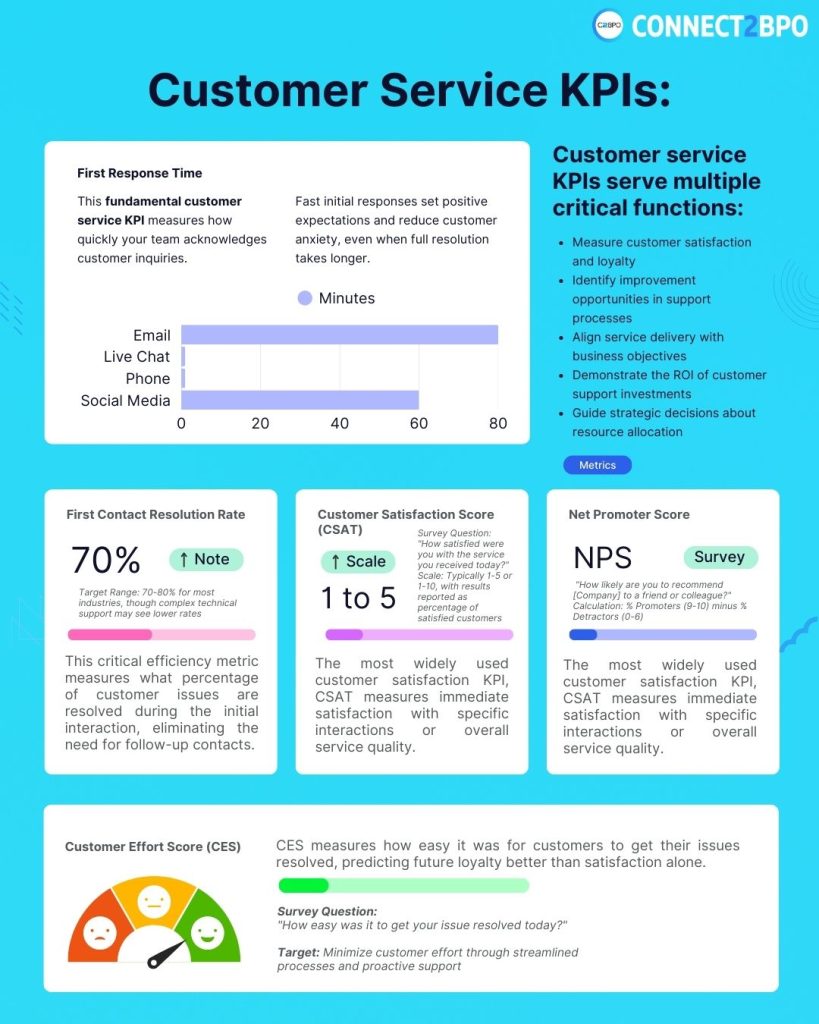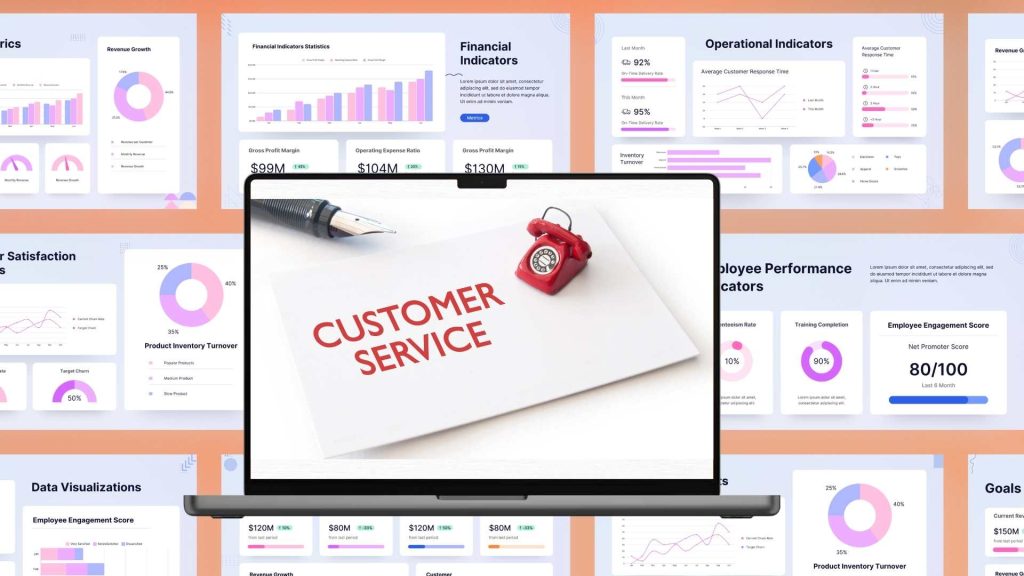Imagine this scenario: Your customer support team receives 500 calls daily, but you only know they “seem busy.” One day, a major client cancels their contract, citing poor service response times. You realize you have no concrete data about how long customers actually wait, how many issues get resolved on the first call, or whether customers leave satisfied.
Now imagine a mid-sized software company, before they implemented customer service KPIs. They discovered their average response time was 8 hours (while competitors averaged 2 hours), only 45% of issues were resolved on first contact, and their customer satisfaction score was 6.2 out of 10. Six months after implementing proper measurement systems, they reduced response time to 90 minutes, improved first-contact resolution to 78%, and boosted satisfaction to 8.4 out of 10. The result? Customer retention increased by 23% and support costs decreased by 15%.
This comprehensive guide explores essential customer care KPI metrics, provides actionable frameworks for measurement, and shows you how to build a data-driven customer support operation that drives real business results.
What Are Customer Service KPIs?
KPI for customer service are quantifiable measurements that evaluate how effectively your support team delivers value to customers. These metrics go beyond simple response times to encompass the entire customer journey, from initial contact through issue resolution and relationship building.
Customer service KPIs serve multiple critical functions:
- Measure customer satisfaction and loyalty
- Identify improvement opportunities in support processes
- Align service delivery with business objectives
- Demonstrate the ROI of customer support investments
- Guide strategic decisions about resource allocation
Why Customer Service KPIs Are Essential for Business Success
Modern KPI customer service measurement has evolved far beyond basic operational metrics. Today’s leading organizations recognize that customer support data provides crucial insights into overall business health and growth potential.
Revenue Impact: Studies consistently show that companies with superior customer service performance achieve 4-8% higher revenue growth than competitors. Effective measurement helps identify and replicate the practices that drive these results.
Customer Lifetime Value: Customer satisfaction KPI tracking reveals the direct correlation between service quality and long-term customer value, enabling more accurate forecasting and resource planning.
Competitive Advantage: In markets where products and pricing are increasingly commoditized, exceptional service becomes a key differentiator. Robust measurement ensures consistent delivery of superior experiences.
Operational Efficiency: Well-designed KPI customer care systems identify process bottlenecks, training needs, and technology gaps that impact both customer experience and operational costs.
Core Customer Service KPI Categories
Response and Resolution Metrics
First Response Time This fundamental customer service KPI measures how quickly your team acknowledges customer inquiries. Fast initial responses set positive expectations and reduce customer anxiety, even when full resolution takes longer.
Best Practice Targets:
- Email: Within 2 hours during business hours
- Live chat: Within 60 seconds
- Phone: Answer within 3 rings
- Social media: Within 1 hour
Average Resolution Time Tracking end-to-end issue resolution provides insights into process efficiency and customer effort required.
Calculation: Total time from initial contact to final resolution, averaged across all resolved cases
First Contact Resolution Rate This critical efficiency metric measures what percentage of customer issues are resolved during the initial interaction, eliminating the need for follow-up contacts.
Target Range: 70-80% for most industries, though complex technical support may see lower rates
Customer Satisfaction and Experience Metrics
Customer Satisfaction Score (CSAT) The most widely used customer satisfaction KPI, CSAT measures immediate satisfaction with specific interactions or overall service quality.
Survey Question: “How satisfied were you with the service you received today?” Scale: Typically 1-5 or 1-10, with results reported as percentage of satisfied customers
Net Promoter Score (NPS) This loyalty metric indicates customers’ likelihood to recommend your company, providing insights into long-term relationship strength.
Survey Question: “How likely are you to recommend [Company] to a friend or colleague?” Calculation: % Promoters (9-10) minus % Detractors (0-6)
Customer Effort Score (CES) CES measures how easy it was for customers to get their issues resolved, predicting future loyalty better than satisfaction alone.
Survey Question: “How easy was it to get your issue resolved today?” Target: Minimize customer effort through streamlined processes and proactive support
Operational Efficiency KPIs
Ticket Volume and Trends Understanding inquiry patterns helps with staffing decisions and identifies recurring issues that need systematic solutions.
Analysis Points:
- Daily/weekly/seasonal volume patterns
- Channel distribution (phone, email, chat, social)
- Category breakdown (billing, technical, general inquiry)
Agent Utilization Rate This productivity metric ensures optimal staffing levels while maintaining service quality.
Calculation: (Time spent on customer interactions / Total available work time) × 100 Target Range: 75-85% to balance efficiency with quality
Cost Per Contact Understanding the true cost of customer service delivery helps optimize channel mix and resource allocation.
Components: Agent wages, technology costs, facilities, training, and management overhead
Customer Relationship KPI Framework
Customer Relationship KPI Essentials
Building lasting customer relationships requires measurement beyond individual transactions. Customer relationship management KPI systems track long-term engagement patterns and relationship health indicators.
Relationship Depth Metrics:
- Customer engagement frequency across channels
- Proactive outreach effectiveness
- Cross-selling and upselling success rates
- Customer advocacy and referral generation
Loyalty Indicators:
- Repeat purchase behavior correlation with service quality
- Contract renewal rates for subscription businesses
- Premium service adoption rates
- Customer lifetime value progression
Customer Experience Management KPI
Customer experience management KPI frameworks encompass the entire customer journey, not just support interactions. These metrics help organizations understand how service quality impacts overall customer perception.
Journey Stage Analysis:
- Onboarding completion rates and satisfaction
- Product adoption milestones and support correlation
- Renewal/retention decision factors
- Exit interview insights and improvement opportunities
Omnichannel Experience Consistency:
- Service quality variance across channels
- Context transfer effectiveness between channels
- Customer preference evolution and channel optimization
Customer Retention KPI Deep Dive
Customer Retention KPI Fundamentals
Customer retention KPI measurement is perhaps the most critical aspect of service performance evaluation. Retained customers typically generate 67% more revenue than new acquisitions, making retention metrics essential for sustainable growth.
Customer Churn Rate The percentage of customers who stop using your product or service within a specific timeframe.
Calculation: (Customers lost during period / Total customers at start of period) × 100 Industry Benchmarks: Vary significantly, from 5% annually for enterprise software to 75% for consumer mobile apps
Customer Retention Rate The inverse of churn rate, showing what percentage of customers continue their relationship with your organization.
Calculation: ((Customers at end of period – New customers acquired) / Customers at start of period) × 100
Retention Revenue Impact Beyond counting customers, measuring the revenue impact of retention efforts provides clearer business value assessment.
Metrics Include:
- Revenue retention rate
- Net revenue churn (accounting for expansion)
- Customer lifetime value improvement
- Retention ROI calculations
Industry-Specific Customer Service KPIs
Return/exchange processing time
Product availability inquiry resolution
Shipping issue resolution rate
Live chat conversion impact
Bug report processing time
Feature request acknowledgment and feedback
Technical documentation effectiveness
System downtime communication quality
Compliance inquiry handling
Account issue resolution time
Regulatory requirement satisfaction
Security incident communication effectiveness
Appointment scheduling efficiency
Insurance verification support
Medical record access assistance
Patient satisfaction correlation with support quality
Advanced Customer Care KPI Analytics
Predictive Customer Health Scoring
Modern customer care KPI systems incorporate predictive analytics to identify at-risk customers before issues escalate.
Early Warning Indicators:
- Declining interaction sentiment scores
- Increased contact frequency patterns
- Service ticket severity trends
- Payment or usage behavior changes
Intervention Strategies:
- Proactive outreach programs
- Dedicated account management assignment
- Customized service level adjustments
- Special retention offer targeting
Sentiment Analysis and Voice of Customer
Real-time Sentiment Tracking: Advanced analytics platforms analyze customer communications across all channels to identify satisfaction trends and emerging issues.
Text and Voice Analytics:
- Keyword and phrase analysis for issue identification
- Emotional tone assessment in customer interactions
- Agent performance evaluation through communication analysis
- Trend identification for proactive problem resolution
Implementation Strategy for Customer Service KPIs
Phase 1: Foundation Building
- Audit current measurement capabilities and data sources
- Identify key stakeholder information needs
- Select initial KPI for customer service metrics for pilot implementation
- Establish baseline performance measurements
Phase 2: System Development
- Implement data collection and integration systems
- Create standardized reporting templates
- Train team members on new measurement approaches
- Develop escalation procedures for KPI threshold breaches
Phase 3: Optimization and Expansion
- Analyze initial results and refine measurement approaches
- Expand metric scope based on early learnings
- Implement advanced analytics and predictive capabilities
- Establish continuous improvement processes
Avoiding Common Customer Service KPI Pitfalls
Over-Emphasis on Speed Metrics: While response time matters, focusing exclusively on speed can compromise quality. Balance efficiency metrics with satisfaction and resolution quality indicators.
Ignoring Customer Effort: Traditional satisfaction surveys may miss friction points in the customer experience. Customer Effort Score provides crucial insights into process improvement opportunities.
Siloed Channel Measurement: Customers expect consistent experience across all touchpoints. Avoid optimizing individual channels at the expense of overall journey quality.
Static Benchmarking: Customer expectations evolve rapidly. Regular benchmark updates ensure your performance targets remain competitive and relevant.

Technology Solutions for Customer Service KPI Tracking
Customer Relationship Management (CRM) Integration
Modern CRM platforms, like HubSpot, provide comprehensive customer relationship management KPI tracking capabilities, consolidating interaction history and performance metrics in unified dashboards.
Key Capabilities:
- Automated case tracking and resolution measurement
- Customer journey mapping and analysis
- Agent performance monitoring and coaching tools
- Predictive analytics for customer health scoring
Specialized Customer Service Analytics Platforms
Dedicated analytics solutions offer advanced measurement capabilities specifically designed for customer service operations.
Advanced Features:
- Multi-channel conversation analysis
- Sentiment tracking across all customer interactions
- Workforce optimization and scheduling integration
- Competitive benchmarking and industry comparison
Survey and Feedback Management Systems
Automated feedback collection ensures consistent measurement of customer satisfaction and experience quality.
Best Practices:
- Strategic survey timing to maximize response rates
- Multi-channel feedback collection capabilities
- Real-time alert systems for negative feedback
- Closed-loop feedback processes for service recovery
Customer Experience Management KPI Integration
Customer experience management KPI systems extend beyond traditional support metrics to encompass the entire customer lifecycle. This holistic approach provides deeper insights into how service quality impacts overall business performance.
Lifecycle Stage Metrics:
- Pre-purchase support effectiveness and sales conversion impact
- Onboarding experience quality and time-to-value achievement
- Ongoing relationship management and expansion opportunities
- Retention and advocacy development through superior service
Cross-Functional Collaboration: Effective customer experience measurement requires integration between customer service, sales, marketing, and product development teams.
Future Trends in Customer Service KPIs
Artificial Intelligence and Automation Impact
AI-Powered Analytics: Machine learning algorithms increasingly provide predictive insights and automated optimization recommendations for customer service operations.
Chatbot and Virtual Assistant Metrics: New KPIs emerge around AI-assisted customer service, including bot resolution rates, escalation accuracy, and customer acceptance of automated support.
Personalization and Individual Customer Metrics
Individual Customer Health Scores: Advanced analytics enable tracking of service quality impact on individual customer relationships, supporting highly personalized service strategies.
Dynamic Service Level Agreements: KPI systems increasingly support variable service levels based on customer value, relationship stage, and individual preferences.
Measuring Customer Service ROI
Connecting customer service KPI performance to financial outcomes demonstrates clear value to organizational leadership:
Revenue Correlation Analysis: Track how improvements in service metrics correlate with customer spending patterns, contract renewals, and expansion purchases.
Cost Avoidance Quantification: Calculate the financial value of issues prevented through proactive service and improved first-contact resolution rates.
Customer Lifetime Value Impact: Measure how service quality improvements extend customer relationships and increase total lifetime value.
Conclusion
Effective customer service KPI implementation transforms support operations from cost centers into strategic business drivers. By selecting the right metrics, implementing robust measurement systems, and consistently acting on insights, customer service teams can demonstrate clear value while continuously improving customer experiences.
The key to success lies in balancing operational efficiency with customer satisfaction, integrating data across all touchpoints, and maintaining focus on metrics that drive both immediate improvements and long-term relationship growth.
Remember that the most sophisticated customer care KPI system is only valuable if it drives better decision-making and improved outcomes for both customers and the organization. Focus on actionable insights rather than impressive dashboards, and you’ll build a measurement framework that truly supports your strategic customer service goals.
Ready to implement comprehensive KPI tracking across your entire organization? Learn about essential business metrics and measurement frameworks in our complete guide to Key Performance Indicators.



